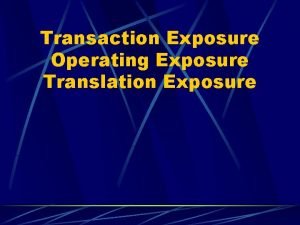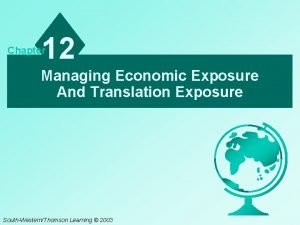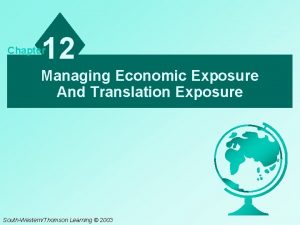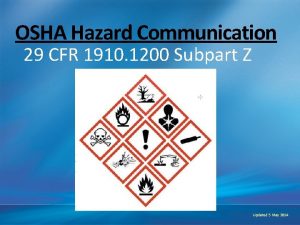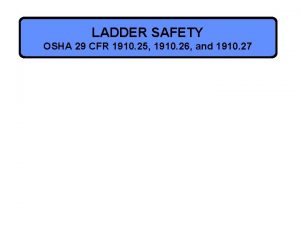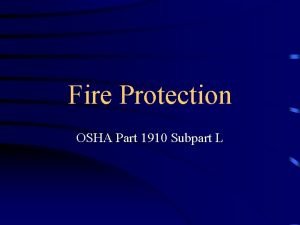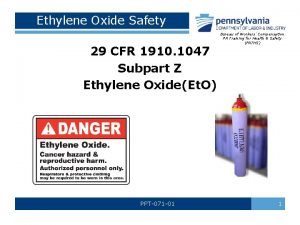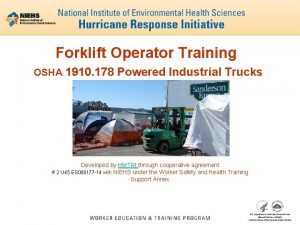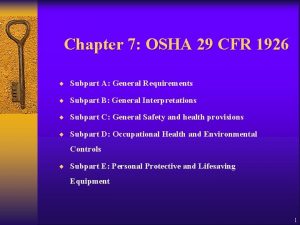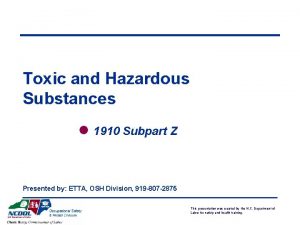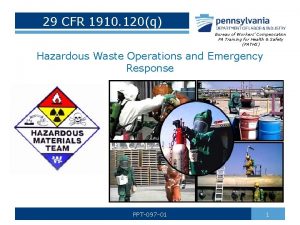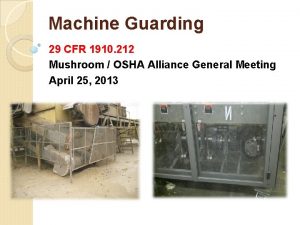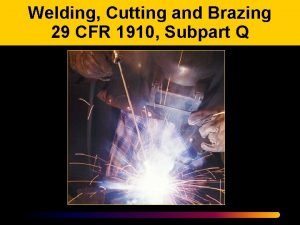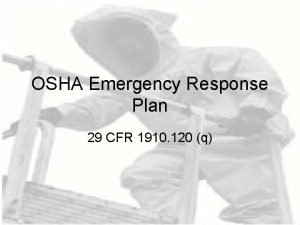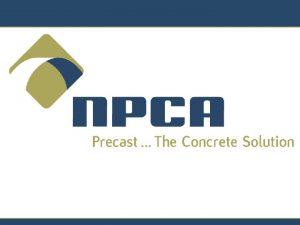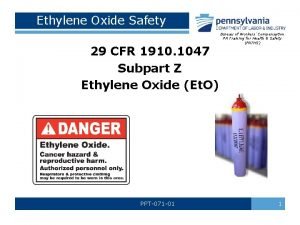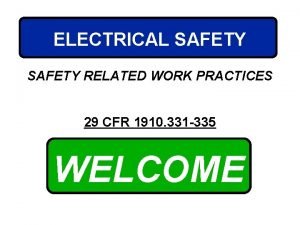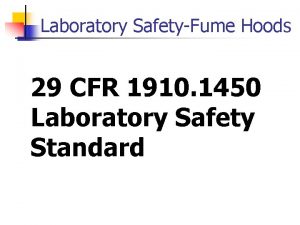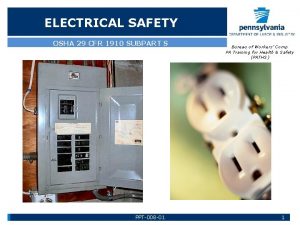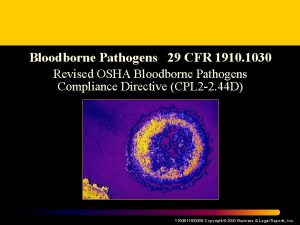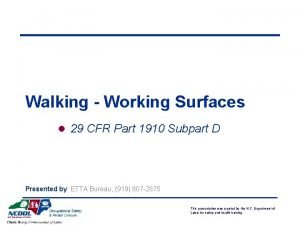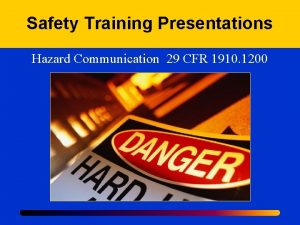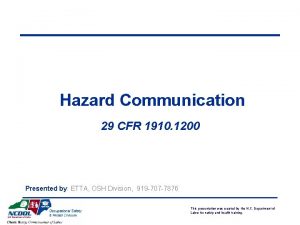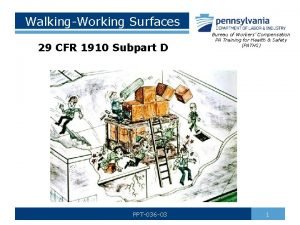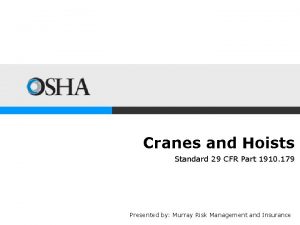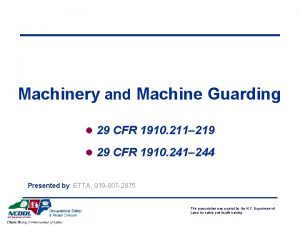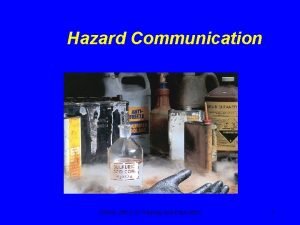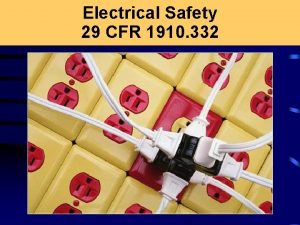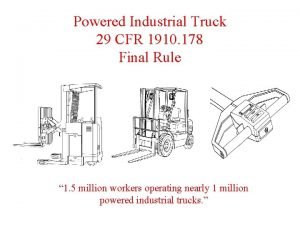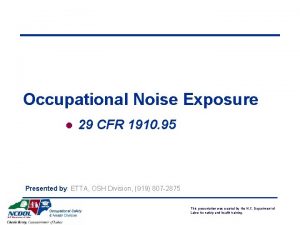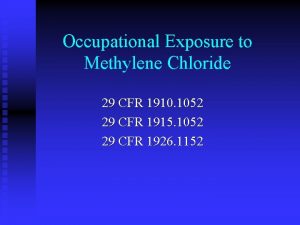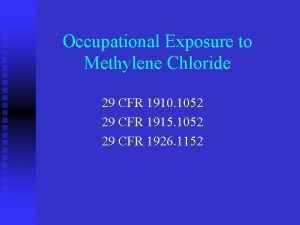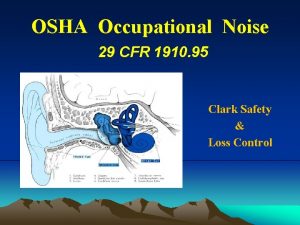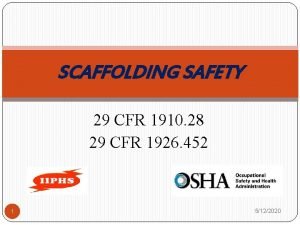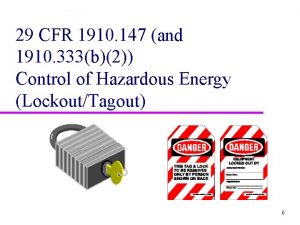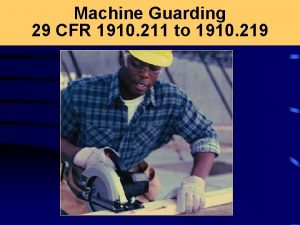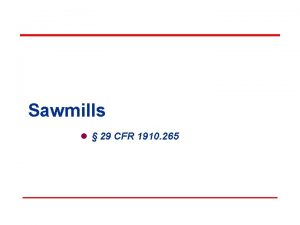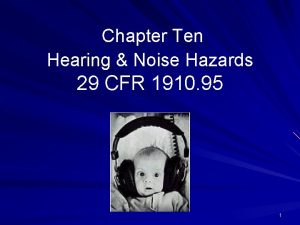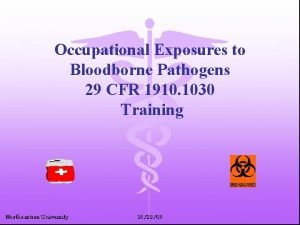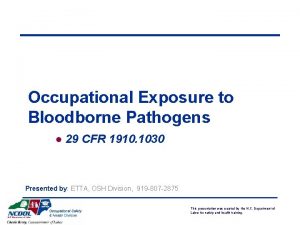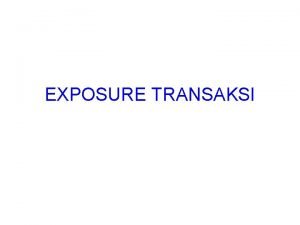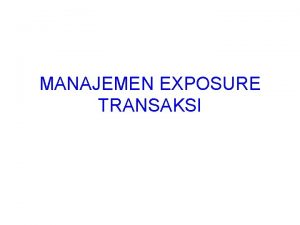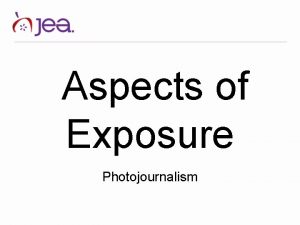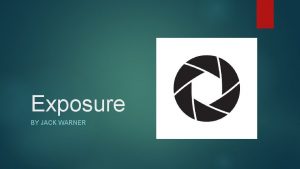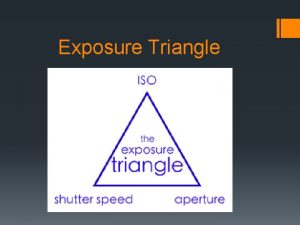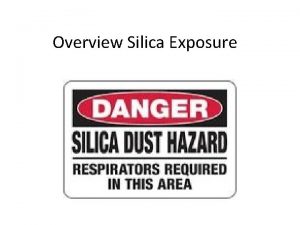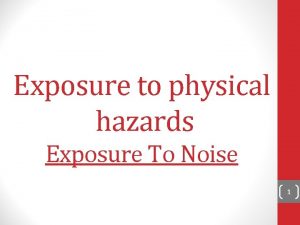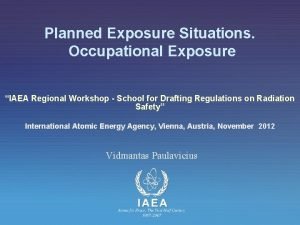Occupational Noise Exposure l 29 CFR 1910 95































- Slides: 31

Occupational Noise Exposure l 29 CFR 1910. 95 Presented by: This presentation was created by the N. C. Department of Labor for safety and health training.

Objectives 29 CFR 1910. 95 l At the end of this course, students will: - Be able to distinguish between sound and noise - Be able list and discuss types of hearing loss - Become familiar with types of noise measuring equipment - Understand the requirements of 29 CFR 1910. 95 This presentation was created by the N. C. Department of Labor for safety and health training.

Sound Versus Noise l Sound is a pressure change detectable by the human ear - Pitch ranges between 20 to 20, 000 hertz (Hz) - Volume ranges between 0 to 140 decibels (d. B) l Noise is a type of sound - Carries no information - Random - Generally described as undesirable or unwanted sound This presentation was created by the N. C. Department of Labor for safety and health training.

An Ear’s Anatomy This presentation was created by the N. C. Department of Labor for safety and health training.

Types of Hearing Loss l Middle ear hearing loss results from lack of conduction - Impacted wax - Broken ear drum l Inner ear hearing loss results from lack of neural connections - Naturally due to aging - Loud noises - Disease This presentation was created by the N. C. Department of Labor for safety and health training.

Occupational Hearing Loss l Noise-induced hearing loss (NIHL) - Initially effects high frequencies » Speech recognition - Temporary threshold shifts (TTS) » Short-term exposure to high noise levels, hearing returns to normal after a period of time - Permanent threshold shifts (PTS) » Prolonged exposure to high noise levels, hearing ranges will not return to normal - OSHA’s standard threshold shifts (STS) » > 10 d. B average loss in 2000, 3000, or 4000 Hz in either ear This presentation was created by the N. C. Department of Labor for safety and health training.

Non-Auditory Effects of Noise l Effects cardiovascular system l Effects the nervous system l Interferes with speech and concentration l Causes annoyance, stress, and fatigue l Reduces work efficiency l Lowers morale This presentation was created by the N. C. Department of Labor for safety and health training.

Noise Measuring Equipment l Sound level meter (SLM) - Basic instrument to measure sound pressure variations in air NCDOL Photo Library l Noise dosimeter - Combines sound pressure and time for employee exposure monitoring This presentation was created by the N. C. Department of Labor for safety and health training.

Noise Measuring Equipment l Octave band analyzer (OBA) - Diagnostic tool to help find appropriate engineering controls to reduce noise levels This presentation was created by the N. C. Department of Labor for safety and health training.

Permissible Exposure Level 1910. 95(b) l No employee shall be exposed above the permissible exposure level (PEL). - PEL = 90 decibels on the A scale (d. BA) for an 8 hour time-weighted average (TWA). l Feasible administrative or engineering controls are required. l Hearing protection provided and used to reduce sound to within levels of Table G -16. This presentation was created by the N. C. Department of Labor for safety and health training.

Table G-16 - Permissible Noise Exposures Duration per day, hours Sound level d. BA slow response 8 6 4 90 92 95 3 2 1. 5 1 0. 5 0. 25 or less 97 100 102 105 110 115 NCDOL Photo Library This presentation was created by the N. C. Department of Labor for safety and health training.

Noise Action Level 1910. 95(c)-(d) l Action level (AL) = 85 d. BA for an 8 -hour TWA - Determined without regard to hearing protector attenuation. l Hearing conservation program (HCP) required when noise exposures equal or exceed the action level. l Monitoring program implemented when noise exposures equal or exceed the action level. This presentation was created by the N. C. Department of Labor for safety and health training.

Monitoring 1910. 95(d) l Strategy to identify all employees who could be exposed at or above the AL (85 d. BA) and to enable proper selection of hearing protectors l Conduct representative sampling - Each job classification - All shifts l Repeat monitoring when: - Change in process, equipment, controls - Additional employees are exposed - Hearing protectors are inadequate This presentation was created by the N. C. Department of Labor for safety and health training.

Notification 1910. 95(e) l Employer shall notify each employee exposed at or above 85 d. BA of the monitoring results. This presentation was created by the N. C. Department of Labor for safety and health training.

Audiometric Testing Program 1910. 95(g) l Audiometric testing program implemented when noise exposures equal or exceed the action level. - Qualified person performs the hearing test, usually an audiologist. - Results interpreted by qualified person. l Audiometer checked before each use and calibrated acoustically annually. - Records of calibrations required. This presentation was created by the N. C. Department of Labor for safety and health training.

Audiometric Testing 1910. 95(g) l Provided at no cost to the employee. - Baseline audiogram within 6 months of first exposure at or above action level. » For mobile test van, < 12 months l Provided initially and annually. - Allowance for aging - STS notification This presentation was created by the N. C. Department of Labor for safety and health training.

Example of an Audiogram This presentation was created by the N. C. Department of Labor for safety and health training.

STS Notification 1910. 95(g) l Recall standard threshold shift definition: - > 10 d. B average loss at 2000, 3000 and 4000 k. Hz l Employer may retest within 30 days to verify the STS. l Audiologist shall determine need for further evaluation. l Employer shall notify the employee of the STS in writing within 21 days. This presentation was created by the N. C. Department of Labor for safety and health training.

Audiogram with 2 STS, 1 PHL – Permanent hearing loss This presentation was created by the N. C. Department of Labor for safety and health training.

STS Requirements 1910. 95(g) l If a work-related STS occurs, employees: - Not using hearing protection shall be fitted for hearing protection and trained. - Shall be refitted and retrained, if already using hearing protection. - Shall be referred for audiological or ontological exam, if necessary and appropriate. This presentation was created by the N. C. Department of Labor for safety and health training.

Hearing Protectors 1910. 95(i) l Shall be available when employees are exposed at or above the “action level”. l Employees are required to use when: - Exposed at or above 90 d. BA - Exposed at or above 85 d. BA » Who has not yet had a baseline audiogram » Experienced an STS This presentation was created by the N. C. Department of Labor for safety and health training.

Hearing Protectors 1910. 95(i) l Provided at no cost to the employee l Selection from a variety of hearing protector types l Properly fitted l Replaced as necessary This presentation was created by the N. C. Department of Labor for safety and health training.

Hearing Protector Attenuation 1910. 95(j) l Hearing protectors shall: - For overexposed employees » Attenuate < 90 d. BA 8 -hr TWA - For employees that had a STS » Attenuate < 85 d. BA 8 -hr TWA - Whenever noise exposures increase » Be reevaluated to determine adequacy This presentation was created by the N. C. Department of Labor for safety and health training.

Noise Reduction Rating (NRR) Appendix B l Defined as the maximum number of decibels that the hearing protector will reduce the sound level when worn. l NRR must be on the hearing protector package. l NRR example for A-weighted NCDOL Photo Library data - Estimated exposure (d. BA) = TWA (d. BA) - (NRR - 7) This presentation was created by the N. C. Department of Labor for safety and health training.

Training 1910. 95(k) l Initially and annually l Must include: - Effects of noise on hearing - Purpose of hearing protectors - Instruction in protector hearing protector selection, fitting, use and care - Purpose of audiometric test and explanation of the procedures and results This presentation was created by the N. C. Department of Labor for safety and health training.

Post the Standard 1910. 95(l) l Employer shall make available to affected employees or their representative’s copies of the standard. l Employer shall also post a copy of the standard in the workplace. This presentation was created by the N. C. Department of Labor for safety and health training.

Recordkeeping 1910. 95(m) l Provide employee and DOL access, and transfer records to successive employer l Noise measurements: > 2 years l Audiometric tests > employment duration: - Name, job classification and d. BA-TWA - Date, examiner’s name and calibration date - Background measurements of audiometric test room This presentation was created by the N. C. Department of Labor for safety and health training.

Other Paragraphs 1910. 95 l (f) - Observation of monitoring l (h) - Audiometric test requirements l (o) - Exemptions Note: 1926. 52 applies to construction This presentation was created by the N. C. Department of Labor for safety and health training.

Appendices 1910. 95(n) l Appendix A - Noise exposure computation l Appendix B - Methods for establishing the adequacy of hearing protector attenuation l Appendix C - Audiometric measuring equipment l Appendix D - Audiometric test rooms l Appendix E - Acoustical calibration of audiometers l Appendix F - Calculations and application of age corrections to audiograms l Appendix G - Monitoring noise levels This presentation was created by the N. C. Department of Labor for safety and health training.

Summary 1910. 95 l In this course, we covered: - The difference between sound and noise - Types of hearing loss - Types of noise measuring equipment - The requirements of 29 CFR 1910. 95 This presentation was created by the N. C. Department of Labor for safety and health training.

Thank You For Attending! Final Questions? This presentation was created by the N. C. Department of Labor for safety and health training.
 Operating exposure
Operating exposure Balance sheet hedge translation exposure
Balance sheet hedge translation exposure Managing economic exposure and translation exposure
Managing economic exposure and translation exposure Managing economic exposure and translation exposure
Managing economic exposure and translation exposure 29 cfr 1910 section 1200
29 cfr 1910 section 1200 Osha 1910 ladders
Osha 1910 ladders Osha subpart for fire protection and prevention
Osha subpart for fire protection and prevention 29 cfr 1910
29 cfr 1910 29 cfr 1910 ppe
29 cfr 1910 ppe 29 cfr 1910 powered industrial trucks
29 cfr 1910 powered industrial trucks Osha 29 cfr 1910 1200
Osha 29 cfr 1910 1200 1910 subpart z
1910 subpart z 29 cfr1910.120
29 cfr1910.120 29 cfr 1910
29 cfr 1910 1910 subpart s
1910 subpart s Osha emergency response plan
Osha emergency response plan 29 cfr 1910 1200
29 cfr 1910 1200 49 cfr 1910
49 cfr 1910 Osha 1910 electrical panel clearance
Osha 1910 electrical panel clearance 29 cfr 1910 osha 178
29 cfr 1910 osha 178 Cfr 29 1910
Cfr 29 1910 Cfr 1910 subpart s
Cfr 1910 subpart s Bloodborne pathogens standard 29 cfr 1910
Bloodborne pathogens standard 29 cfr 1910 Osha racking requirements 1910
Osha racking requirements 1910 29 cfr 1910 osha 178
29 cfr 1910 osha 178 29 cfr1910.1200
29 cfr1910.1200 Ppt-036
Ppt-036 Osha crane standard 1910
Osha crane standard 1910 Cfr
Cfr Osha cfr 1910 is the standard for______.
Osha cfr 1910 is the standard for______. A person usually offers the most resistance to electricity
A person usually offers the most resistance to electricity 29 cfr 1910 powered industrial trucks
29 cfr 1910 powered industrial trucks
